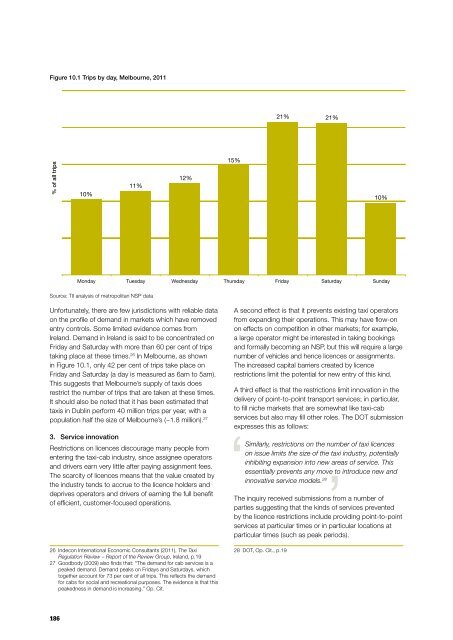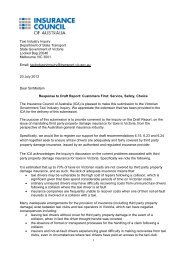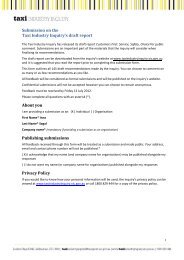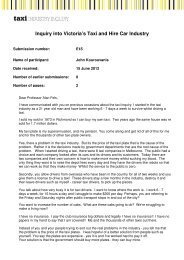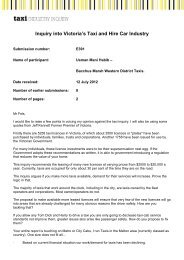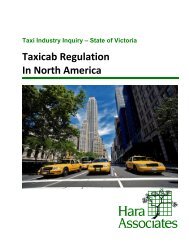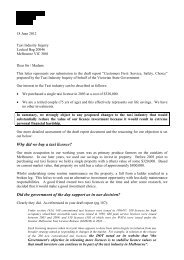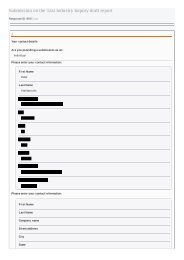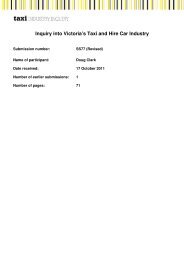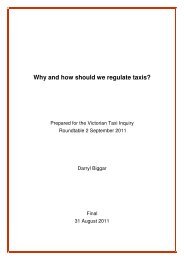Part D â Understanding and improving industry performance (PDF ...
Part D â Understanding and improving industry performance (PDF ...
Part D â Understanding and improving industry performance (PDF ...
Create successful ePaper yourself
Turn your PDF publications into a flip-book with our unique Google optimized e-Paper software.
Trip distribution across the week, Metropolitan Melbourne, 2011<br />
Figure 10.1 Trips by day, Melbourne, 2011<br />
21% 21%<br />
% of all trips<br />
10%<br />
11%<br />
12%<br />
15%<br />
10%<br />
Monday Tuesday Wednesday Thursday Friday Saturday Sunday<br />
Source: TII analysis of metropolitan NSP data<br />
Unfortunately, there are few jurisdictions with reliable data<br />
on the profile of dem<strong>and</strong> in markets which have removed<br />
entry controls. Some limited evidence comes from<br />
Irel<strong>and</strong>. Dem<strong>and</strong> in Irel<strong>and</strong> is said to be concentrated on<br />
Friday <strong>and</strong> Saturday with more than 60 per cent of trips<br />
taking place at these times. 26 In Melbourne, as shown<br />
in Figure 10.1, only 42 per cent of trips take place on<br />
Friday <strong>and</strong> Saturday (a day is measured as 6am to 5am).<br />
This suggests that Melbourne’s supply of taxis does<br />
restrict the number of trips that are taken at these times.<br />
It should also be noted that it has been estimated that<br />
taxis in Dublin perform 40 million trips per year, with a<br />
population half the size of Melbourne’s (~1.8 million). 27<br />
3. Service innovation<br />
Restrictions on licences discourage many people from<br />
entering the taxi-cab <strong>industry</strong>, since assignee operators<br />
<strong>and</strong> drivers earn very little after paying assignment fees.<br />
The scarcity of licences means that the value created by<br />
the <strong>industry</strong> tends to accrue to the licence holders <strong>and</strong><br />
deprives operators <strong>and</strong> drivers of earning the full benefit<br />
of efficient, customer-focused operations.<br />
26 Indecon International Economic Consultants (2011), The Taxi<br />
Regulation Review – Report of the Review Group, Irel<strong>and</strong>, p.19<br />
27 Goodbody (2009) also finds that: “The dem<strong>and</strong> for cab services is a<br />
peaked dem<strong>and</strong>. Dem<strong>and</strong> peaks on Fridays <strong>and</strong> Saturdays, which<br />
together account for 73 per cent of all trips. This reflects the dem<strong>and</strong><br />
for cabs for social <strong>and</strong> recreational purposes. The evidence is that this<br />
peakedness in dem<strong>and</strong> is increasing.” Op. Cit.<br />
A second effect is that it prevents existing taxi operators<br />
from exp<strong>and</strong>ing their operations. This may have flow-on<br />
on effects on competition in other markets; for example,<br />
a large operator might be interested in taking bookings<br />
<strong>and</strong> formally becoming an NSP, but this will require a large<br />
number of vehicles <strong>and</strong> hence licences or assignments.<br />
The increased capital barriers created by licence<br />
restrictions limit the potential for new entry of this kind.<br />
A third effect is that the restrictions limit innovation in the<br />
delivery of point-to-point transport services; in particular,<br />
to fill niche markets that are somewhat like taxi-cab<br />
services but also may fill other roles. The DOT submission<br />
expresses this as follows:<br />
Similarly, restrictions on the number of taxi licences<br />
on issue limits the size of the taxi <strong>industry</strong>, potentially<br />
inhibiting expansion into new areas of service. This<br />
essentially prevents any move to introduce new <strong>and</strong><br />
innovative service models. 28<br />
The inquiry received submissions from a number of<br />
parties suggesting that the kinds of services prevented<br />
by the licence restrictions include providing point-to-point<br />
services at particular times or in particular locations at<br />
particular times (such as peak periods).<br />
28 DOT, Op. Cit., p.19<br />
186


